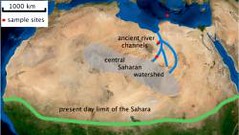
Map illustrates possible migration of population groups out of Africa. This theory is being advanced through an article in New Scientist magazine.
Originally uploaded by Pan-African News Wire File Photos
11:15 14 October 2008
http://www.NewScientist.com news service
by Ewen Callaway
The first humans to leave Africa didn't have to struggle over baking sand dunes to find a way out – instead they might have followed a now-buried network of ancient rivers, researchers say.
Chemical analysis of snail fossils suggests that monsoon-fed canals criss-crossed what is now the Sahara desert as modern humans first trekked out of Africa.
Now only visible with satellite radar, the channels flowed intermittently from present-day Libya and Chad to the Mediterranean Sea, says Anne Osborne, a geochemist at the University of Bristol, UK, who led the new study.
Up to five kilometres wide, the channels would have provided a lush route from East Africa – where modern humans first evolved – to the Middle East, a likely second stop on Homo sapiens' world tour.
Archaeological, genetic and palaeontological evidence have pointed to the Nile River Valley and Red Sea as other potential alleys for human migration out of Africa.
Watery clues
To make a case for the channels, Osborne's team excavated snail fossils buried by half a metre of sand from a channel in Libya and compared their chemical makeup to snails excavated from volcanoes hundreds of kilometres away.
By measuring the decay of a radioactive metal locked into the shells, Osborne's team showed that the buried snails must have come from the volcanoes – almost certainly carried there by water.
Other climate records point to a sometimes-green Sahara around this time, and Osborne thinks that seasonal monsoons could have supported a patchwork of life-saving oases across the desert.
Chris Stringer, a palaeoanthropologist at London's Natural History Museum, says Osborne's team makes a good climatological case for the importance of the Saharan channels in human migrations.
North African human bones and artefacts closely match those in the Middle East, but, he says, a greener Sahara could have connected already existing populations in both spots to achieve the same effect.
Better proof could come with archaeological finds documenting a human migration across the Sahara, he says. Yet it's a task that few researchers have taken on so far. "It's up to the archaeologists now to go and have a search," Osborne says.
Journal reference: PNAS (DOI: 10.1073/pnas.0804472105)
Related Articles
Nearly out of Africa
http://environment.newscientist.com/article/mg16021551.800
10 October 1998
Ancient genetic imprint unites the tribes of India
http://environment.newscientist.com/article/dn14708
11 September 2008
Interview: Footsteps in the sand
http://environment.newscientist.com/article/mg18925441.700
25 March 2006
Out of Africa and straight to the beach
http://environment.newscientist.com/article/dn7371
12 May 2005
Weblinks
Anne Osborne, University of Bristol
http://eis.bris.ac.uk/~glaho/index.html
Chris Stringer, Natural History Museum
http://www.nhm.ac.uk/research-curation/staff-directory/palaeontology/cv-5508.html
No comments:
Post a Comment